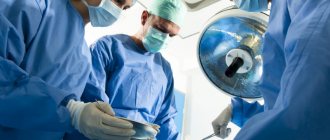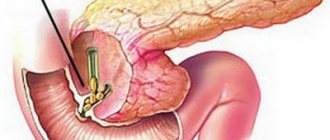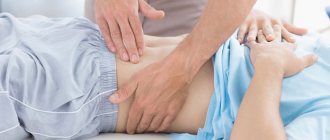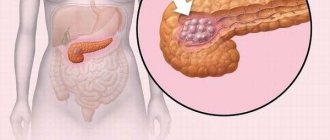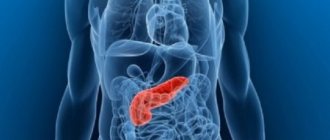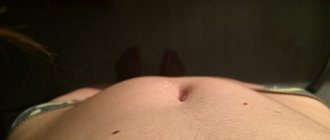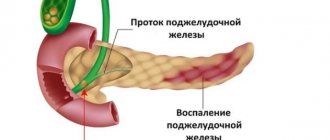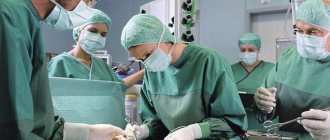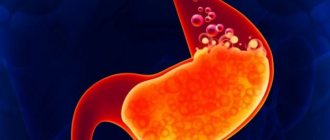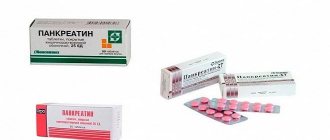What is pancreatic necrosis of the pancreas?
The development of this disease occurs as a result of disruption of the functioning of the local protective mechanism of the pancreas. A provoking factor can be the consumption of junk food and alcoholic beverages in large quantities. As a result, the production of external secretion increases and the outflow of pancreatic juice is disrupted, which provokes a significant stretching of the pancreatic ducts.
The further process of destruction of the acini of the gland and the formation of edema provoke massive tissue necrosis. The penetration of tissue breakdown products and enzymes into the blood causes toxic poisoning of the entire body. As a result, the liver, heart, kidneys and brain can become foci of intoxication.
If conventional treatment methods fail to produce positive results and total and subtotal tissue necrosis does not stop, then the patient is prescribed surgery. Surgical intervention is carried out after the exacerbation of the disease.
Parenteral nutrition and fasting
In the first days of the disease, for a certain period before and after surgery, the patient is assigned a zero table, which leads to enzymatic rest of the pancreas: at this stage, the organ rests without producing juice that is harmful to it during pancreatic necrosis.
To avoid exhaustion, the patient receives parenteral nutrition, in which the beneficial substances necessary for the body are injected directly into the blood.
The composition of the injection solution, calculated based on energy needs by a nutritionist, most often consists of a 20% glucose solution with the addition of solutions of amino acids, fat emulsions, insulin and other components.
General rules of nutrition before and after surgery
The patient must follow a diet for pancreatic necrosis of the pancreas, both after and before surgery. 24 hours before the start of the intervention, the patient is strictly prohibited from consuming food or any liquid. Thus, the pancreas will not produce enzymes involved in the digestion of its parenchyma.
Despite a strict diet for pancreatic necrosis, before the procedure the patient must have the strength to endure the operation, so he is injected intravenously with various substances that support the body.
After surgery, the patient is allowed to feed only on the sixth – seventh day. Before this, it is maintained with warm medicinal water (Narzan, Borjomi) or weak tea without sugar. The volume of fluid consumed should not exceed 800 milliliters per day. If the patient's condition after surgery is considered too severe, drinking any liquid is again prohibited. Nutrition occurs through intravenous injections. Only when a person’s condition returns to normal will foods that promote the regeneration of the digestive system be included in his diet.
The postoperative diet menu for pancreatic necrosis is based on the elimination of negative factors that destroy the pancreas. It is also aimed at reducing the excitability of the gallbladder and eliminating pathogens of pancreatic secretion.
Previously, it was believed that a diet after pancreatic necrosis in the form of prolonged fasting without drinking (about three days) promotes postoperative recovery. However, modern medicine has decisively abandoned this concept.
Recent scientific studies have proven that if the patient is not allowed to drink warm medicinal water after surgery, lipolysis and hypodysproteinemia may develop. Thus, the duration of a fasting diet for pancreatic necrosis of the pancreas does not exceed one day, and in extremely difficult cases it is abandoned altogether. Then the patient, after parenteral nutrition, is gradually transferred to eating dietary food. This postoperative recovery regimen has been proven to be the most effective. It is worth remembering that liquid, even in small quantities, will benefit the patient after surgery.
The diet menu for pancreatic necrosis of the pancreas includes low-calorie foods. The daily mass fraction of proteins in products should not exceed sixty grams. However, you are allowed to consume no more than fifty grams of fat per day. The main element of the diet should be carbohydrate foods with a semi-liquid or viscous consistency.
Parenteral nutrition
It is worth remembering that the disease more often appears in people suffering from pancreatitis and who do not adhere to the diet prescribed by their doctor.
If there are disturbances in the functioning of the pancreas, it becomes difficult for the body to digest food. This applies even to light foods. Therefore, it is so important to follow all doctor’s recommendations regarding diet. And although the treatment of this disease involves surgery, this does not mean that you can ignore other doctor’s recommendations.
A few days before the operation, the patient is strictly forbidden to eat food. And it is during this period, as statistics show, that many succumb to the temptation to secretly have a little snack from the doctor. Such behavior will have very serious consequences. After all, restrictions are introduced with the aim of causing the pancreas to stop producing certain enzymes.
It is these enzymes that destroy the nerve endings, tissues and blood vessels of the organ that has been affected by the disease. The patient is also prohibited from drinking. In the preoperative period, normal functioning of the body is maintained by administering intravenous solutions. The solutions used contain all the necessary nutrients (fats, glucose, amino acids).
After the operation, the patient’s nutrition is completely controlled by the doctor. In the first few days, the patient cannot eat or drink water on his own. The vital functions of the body are maintained in the same way that was used before the operation. And only on the 5th day the patient is allowed to start drinking liquid. This can be not only ordinary water, but also a rosehip decoction. You can drink about 4 glasses per day.
During the first days after surgery, the patient's condition is carefully monitored by medical professionals. And if the patient is gradually recovering and no complications are identified, he is prescribed the Pevzner diet. Following a diet for pancreatic necrosis of the pancreas involves complete exclusion of fatty foods from the diet.
A limited diet of foods for pancreatitis will help the body normalize its functioning faster. The diet recommended by the doctor must be followed for 20-30 days. In this case, everything depends on the decision of the attending physician. In the future, if the patient’s well-being significantly improves, the diet can be gradually expanded and other products added to it.
The nutrition menu for acute pancreatitis is quite meager. At the initial stage of diet therapy, dishes in the diet are present only in boiled and mashed form. You are allowed to eat 50 g of white bread crackers. The menu for the week can be varied if it includes liquid and semi-viscous porridges from various cereals (except millet), soufflé and puree from permitted vegetables.
You need to prepare fresh unleavened cottage cheese every day. It is prepared from milk, adding calcium chloride while boiling, thus obtaining non-acidic calcined cottage cheese. You can use it to make pasta, souffles and steam puddings. Milk is allowed only as an additive to dishes (porridge with milk, cream soups). 1-2 eggs per day are allowed - soft-boiled, white omelet or steamed.
| Breakfast |
|
| Lunch |
|
| Dinner |
|
| Afternoon snack | |
| Dinner |
|
| For the night |
| Breakfast |
|
| Lunch | |
| Dinner |
|
| Afternoon snack |
|
| Dinner |
|
| For the night |
| Breakfast |
|
| Lunch |
|
| Dinner |
|
| Afternoon snack | |
| Dinner |
|
| For the night |
Further, the diet involves expanding the diet. When switching to the extended version, the main dishes are the same, but the products (vegetables and fruits) can no longer be pureed, and a little later - raw. The amount of wheat bread is increased to 300 g, butter to 20-30 g per day, unsweetened dry cookies are allowed.
Since nutrition during the remission stage is very important, it makes sense to consider in more detail the nutrition menu for chronic pancreatitis. Soups are cooked the same way - with cereals and vegetables, and maybe with noodles. Eating okroshka, cabbage soup and borscht is not allowed. The meat should be without tendons and fat. It is prepared in boiled and chopped form (cutlets, puree, soufflé, dumplings, finely chopped beef stroganoff). Chicken, rabbit and veal can be eaten in pieces. Low-fat fish is allowed in boiled pieces or chopped.
| Breakfast |
|
| Lunch | |
| Dinner |
|
| Afternoon snack | |
| Dinner |
|
| For the night |
| Breakfast |
|
| Lunch |
|
| Dinner |
|
| Afternoon snack | |
| Dinner |
|
| For the night |
| Breakfast | |
| Lunch | |
| Dinner |
|
| Afternoon snack | |
| Dinner |
|
| For the night |
| Breakfast |
|
| Lunch | |
| Dinner |
|
| Afternoon snack |
|
| Dinner |
|
| For the night |
| Breakfast |
|
| Lunch | |
| Dinner |
|
| Afternoon snack | |
| Dinner |
|
| For the night |
This menu can be used for pancreatitis and gastritis.
The nutrition menu for pancreatic necrosis of the pancreas is based on the form of the disease, clinical symptoms and the patient’s condition. In the acute period, the diet includes a minimum of foods, and as the process subsides, a gradual transition to a less sparing diet is carried out. However, at any stage, nutrition must be selective and observed over a long period or for life. At the same time, even after treatment, severe dietary violations are undesirable.
We suggest you familiarize yourself with: Quail eggs and cholesterol content and effect on increasing levels
After surgery for pancreatic necrosis, the patient needs a long time to restore the functions of the digestive system. To make this process easier, you can eat:
- fruits - you can only eat ripe and non-acidic fruits;
- all food should have a uniform consistency, since any solid particles greatly complicate the process of digestion in the stomach and intestines;
- drinks - you can drink juices without sugar, compotes, weak tea, rosehip decoction;
- dairy products - only skim milk and low-fat cottage cheese are allowed.
The basis of the diet after acute pancreatic necrosis consists of ground porridge (buckwheat or oatmeal), chopped steamed vegetables, egg omelet, lean meat and poultry (carefully ground).
Since fats are necessary for the normal functioning of the body, you can compensate for their lack in the diet by eating a small piece of butter (no more than 10 g) or adding a teaspoon of olive or sunflower oil to ground foods.
The following products are prohibited:
- sweets and flour;
- smoked meats;
- conservation;
- rich vegetable and meat broths;
- high fat dairy products;
- sausages;
- beans and corn;
- vegetables (cabbage, onions, peppers);
- seasonings and various spices;
- soup with added mushrooms;
- grape juice;
- fatty meat and fish;
- alcoholic drinks;
- strong coffee, chocolate and cocoa.
You need to eat small portions throughout the day, 5-6 times a day. This will minimize the load on the gastrointestinal tract and ensure faster recovery of the body.
The patient must adhere to a special menu for pancreatic necrosis and all other doctor’s instructions until the symptoms of the disease and digestive disorders completely disappear, until all test parameters are within normal limits.
When a disease is detected, the patient is prescribed fasting, which stops the functioning of the glands that produce juice. To prevent the body from becoming depleted, artificial or parenteral nutrition is introduced; the necessary nutrients are injected directly into the blood, bypassing the gastrointestinal tract.
The doctor calculates the required calorie dose and selects nutrient solutions, which are most often a 20 percent glucose solution; amino acids and fats are also added.
The greatest energy value is provided by fat emulsions, which restore missing energy and stabilize cells in the pancreas, preventing the destruction of the organ.
A similar diet for pancreatic necrosis is prescribed before the operation and after for a week.
Authorized Products
The diet for pancreatic necrosis of the pancreas should include vegetables (zucchini, carrots, potatoes). It is recommended to prepare lean first courses from them or to use them boiled and chopped. Porridges based on ground cereals (buckwheat, rice) are prepared in the same way.
First and second courses are allowed to be salted, but only if the total amount of salt per day does not exceed two grams. In a slightly stale form, you can use baked goods made from first-grade flour.
For fruits, we recommend non-acidic apples baked or as part of a mousse. In addition, you can eat apricots and peaches, but only in small quantities and peeled. It is recommended to drink medicinal water, rosehip decoction, jelly or weak tea.
General rules
An inflammatory disease of the pancreas is called pancreatitis. The gland performs secretory functions: it produces insulin, lipocaine and glucagon, and participates in digestion through the secretion of pancreatic juice. The causes of its damage are varied: toxic poisoning, trauma, obstruction of the pancreatic duct, vascular disorders, diseases of the gallbladder and ducts, exposure to drugs, infectious and parasitic diseases.
There are acute and chronic pancreatitis. Acute pancreatitis is associated with enzymatic self-digestion (autolysis) of the pancreas and in severe cases, necrosis of the tissue of the gland and nearby organs is observed. Often develops when taking medications (methyldopa, Azathioprine, 5-aminosalicylates, tetracyclines, Furosemide, Cimetidine, Metronidazole). In half of the cases, the cause of its development is cholelithiasis, and some are associated with alcohol abuse.
Chronic pancreatitis is a long-term and progressive disease, prone to exacerbations. There are several clinical forms:
- asymptomatic;
- painful – not expressed constant pain, intensifying during exacerbation;
- recurrent, when pain appears only during exacerbation;
- pseudotumorous - an extremely rare form, when the head of the gland grows with fibrous tissue and enlarges.
Tissue changes in chronic pancreatitis are persistent, progressive and lead to exocrine insufficiency. In the initial stage, the pathological process is limited, and as the disease develops, the entire gland is affected.
The main symptoms of acute pancreatitis are severe abdominal pain of different localization (in the right or left hypochondrium, epigastric region, girdles), belching, dry mouth, severe vomiting, nausea, fever. Symptoms depend on the degree of damage to the gland. Thus, a mild degree is accompanied by single vomiting, moderate pain and a relatively satisfactory condition of the patient.
Treatment is aimed at:
- fight against shock and toxemia;
- suppression of enzyme activity (hunger and proton pump inhibitors);
- elimination of pain.
Treatment with diet for symptoms of pancreatitis plays an important role in all periods of the disease. Patients with severe forms are treated with infusion therapy and tube feeding with enteral nutrition mixtures. In the therapeutic nutrition of patients with mild and moderate severity, phasing is important - a gradual transition from hunger to a physiologically complete diet (therapeutic diet number 5P).
In the acute period, proper nutrition suppresses hyperfermentation of the gland and helps reduce stasis in the ducts and gastric secretion. A diet for chronic inflammation of the pancreas helps improve the function of the pancreas, restore nutritional disorders and prevent relapses.
We invite you to read: Voltaren (gel, suppositories, injections): instructions for use
In the acute form of the disease, intense pain syndrome, fermentemia (increased levels of gland enzymes in the blood) and amylasuria (in the urine) are noted.
The main goal is to stop the production of pancreatic juice, which is achieved by refusing to eat any food and strict bed rest. Even the sight and smell of food on the patient is undesirable. The basic principles of nutrition during this period are:
- hunger and parenteral nutrition;
- as soon as possible after an attack and the pain subsides, a transition to nutrition is made, since the patient needs complete protein;
- gradual expansion of the diet and inclusion of new products;
- gradual increase in the volume of food and its calorie content;
- compliance with mechanical and chemical sparing of the organ for a long time.
In the first days, you are allowed to drink: alkaline mineral water (Borjomi, Smirnovskaya, Essentuki No. 17), rosehip decoction, boiled water, weak tea. They should be taken at room temperature and in small portions. The duration of fasting is usually 1-3 days, depending on the patient’s condition. There are several opinions regarding the nature of fasting. Some believe that it is necessary to avoid drinking liquids. Others are inclined to believe that the patient should drink 1.5-2 liters of fluid.
Further nutrition depends on the patient’s condition, and two diet options are sequentially prescribed.
The first option is indicated after acute pancreatitis and with severe exacerbation of chronic pancreatitis. This diet option is recommended after fasting days (usually from the third day), as it creates maximum rest for the gland and eliminates pain.
After an attack, frequent meals are required (up to 8 times) and in very small portions, starting from 50-100 g. At first, a low-calorie diet is prescribed (fat 50 g, protein 60 g). It does not meet physiological standards, so it is recommended for up to 4-7 days.
The diet consists of boiled foods with a semi-liquid consistency, and only by the 6th day is the consumption of semi-viscous food allowed. Carbohydrate foods stimulate pancreatic secretion the least, so they are recommended immediately after fasting. If you plan it by day, then on the first and second day you can:
- pureed liquid porridge;
- slimy unsalted soups - decoctions of cereals (millet and corn cereals are excluded);
- vegetable decoctions;
- weak tea with sugar;
- mashed compotes;
- white stale bread, crackers;
- jelly and jelly made from fruit juice with the addition of xylitol.
After 2 days, protein foods are gradually introduced to carbohydrate foods:
- from the third day - curd paste, soufflé, curd puddings made from non-acidic cottage cheese (calcined cottage cheese is more often used);
- 1-2 eggs per day (steam omelet);
- from the fourth day - porridge with milk and cream soup made from boiled meat;
- on the sixth day, butter is added to dishes, already pureed vegetable soups are allowed (cabbage is excluded) and vegetable purees (carrots, potatoes, beets);
- from day 7, meat and fish soufflé is introduced into the diet, and from day 10 - steamed cutlets, dumplings from beef, turkey, chicken, fish (tendons, skin and fat are removed).
When pain decreases and food digestion improves, the diet is expanded and its second option is prescribed (it is also used for mild exacerbation of chronic pancreatitis). After acute pancreatitis, the patient should be on a diet for 6-12 months. All dishes are prepared boiled or steamed, first pureed, and a little later simply chopped. Since the principles of sparing are maintained, food does not cause excessive stimulation of the organ.
In adults, the disease becomes chronic, which means that nutrition should be given due attention, since it can prevent exacerbations. Each exacerbation entails the replacement of normally functioning gland tissue with fibrous tissue. Therefore, over the years, the patient develops exocrine and intrasecretory gland insufficiency.
Exocrine insufficiency or pancreatopathy manifests itself in insufficient production of digestive enzymes (amylase, lipase, trypsin), which respectively break down and digest carbohydrates, fats and proteins. Patients develop steatorrhea (undigested fat) and signs of malnutrition (weight loss, weight deficiency, calcium metabolism disorders).
The diet during exacerbation of chronic pancreatitis is followed within the limits of the options described above: for severe exacerbation - the first option, for mild exacerbation - the second. This is a complete diet containing 110-120 g of protein, the fat content is at the lower limit of the norm (vegetable fats are included) and simple carbohydrates are limited.
Main characteristics of the second version of the 5P Diet:
- Boiled dishes in pureed and chopped form. The transition to such a diet is carried out gradually.
- Increased protein content, fat and carbohydrates. However, the amount of fat is no more than 70 g and is introduced gradually.
- If protein foods are poorly digested, the amount of protein is reduced temporarily and the content of carbohydrates is increased.
- Extractives and fiber are excluded. To extract extractive substances, the meat is cooked in pieces of 100 g, draining the first water. Then it is used as a semi-finished product for various dishes (chopped meat, soufflés and puddings).
- Amount of salt up to 6 g.
- Small meals are recommended (up to 6 times a day).
- Large meals are prohibited.
The diet widely uses foods that are inhibitors of proteolytic enzymes: potatoes, soybeans, egg whites, oatmeal. What diet should I follow in the future? If the second table option is satisfactory, additional fat is introduced into the diet.
Dishes with a juice effect are contraindicated for patients: meat, bone, mushroom and fish broths, fried foods. It is fundamentally important to avoid alcoholic beverages, since they are strong stimulants of pancreatic secretion.
During the period of remission, the list of products expands and the inclusion of vegetables and fruits in raw form is indicated. Vegetables are used in salads, side dishes, vinaigrettes and as independent dishes. In addition to porridges, you can make pilaf with dried fruits and boiled meat, pasta, and cereals. Soups are prepared without puree and beetroot soup, borscht and cabbage soup are carefully introduced. Homemade sauces and spices are used to improve the taste.
Cocoa, coffee, carbonated drinks and alcohol remain contraindicated. During the remission stage, the intake of low- and medium-mineralized mineral waters is indicated. They are taken warm for a course of 3-4 weeks. The diet for chronic pancreatitis is followed for life.
Adults often have concomitant gastrointestinal diseases (cholecystitis, gastritis) and the technology of cooking food (mashed or pureed), as well as the inclusion or, conversely, exclusion of any foods from the diet, depends on this.
Prohibited Products
It is strictly forbidden to include in the diet for pancreatic necrosis smoked products (meat or sausages), fatty and rich broths from fish or meat, fresh milk and fermented milk products with a high fat content. In addition, you should exclude fresh baked goods, scrambled eggs and hard-boiled chicken or quail eggs.
It is strongly recommended not to drink alcohol, any carbonated drinks, coffee, or strong tea. You will have to give up vegetables that contain coarse fiber, as well as hot spices, salt and sugar. Failure to comply with these prohibitions directly leads to relapse of the disease.
Diet after pancreatic necrosis
After surgical treatment, when the symptoms of pancreatic necrosis subside, the diet is expanded. On the fifth day after surgery, the patient is allowed to drink a glass of rosehip decoction or alkaline mineral water without gas no more than 4 times a day.
If the condition does not worsen within two days, the patient is transferred to diet No. 5P, according to which a split diet is prescribed up to 6 times a day with three main meals. Products should be warm, boiled or steamed without salt or spices.
Diet No. 5P completely excludes the consumption of fatty, salty, spicy, fried foods and alcohol in case of pancreatic necrosis. The first courses are prepared from cereals and pureed vegetables - carrots, potatoes, pumpkins, zucchini. For side dishes cooked in water from rice, buckwheat, oatmeal or noodles, you can serve low-fat fish, poultry or meat.
In addition, you can take the following foods as the basis of your diet:
- stale baked goods made from 1st or 2nd grade flour;
- unsweetened cookies and crackers;
- soft and ripe fresh fruits;
- baked apples, jellies, mousses;
- low-fat fermented milk products;
- egg white omelet;
- butter and vegetable oil in dishes;
- rosehip decoction, weak tea, dried fruit compotes and juices without sugar or preservatives.
Features of the diet for children
An approximate diet menu for pancreatic necrosis of the pancreas for children has some differences with the diet of adults. For example, for children under three years of age, it is necessary to completely exclude freshly squeezed juices, berries with seeds, all citrus fruits, as well as any vegetables and fruits.
Otherwise, the diet for adults and children is absolutely identical. It is worth paying attention to the fact that in kindergartens and schools the nutrition is unified and that the staff must be notified in advance that a particular child requires a separate dietary meal.
Nutrition for pancreatitis during exacerbation
Often, in the phase of exacerbation of the disease, the patient is admitted to the hospital, where the first thing he does is wash out his stomach.
Always, regardless of whether you are at home or in a hospital, in the first few days it is forbidden to eat any food, that is, for 2-3 days you can only drink water, purified non-carbonated, or alkaline Borjomi (you must first release the gas), called This stage of treatment is a zero diet. The daily volume of water should be no more than 1.5 liters (5-7 glasses). If the zero diet is extended for a longer period, then starting from the fourth day, various nutritional components are administered intravenously, and from the sixth to seventh day, liquid food is allowed to be introduced through a tube into the intestines.
After the symptoms subside and the patient’s general condition improves, certain foods and drinks are gradually introduced into the diet: porridge cooked in water; unsweetened compotes, jelly; puree soups.
Food can be eaten warm, it is strictly forbidden to be hot or cold, it must be prepared without adding vegetable or animal fat, contain as little protein as possible, and must also be liquid or semi-liquid in consistency, with a minimum calorie content.
When the patient’s well-being and condition have stabilized, you can expand your diet to vegetables, lean meats, fish, boiled or steamed potatoes; this stage of the disease no longer requires crushing to a puree state.
Principles of nutrition during exacerbation of pancreatitis and immediately after it:
- small, frequent meals, 5 to 7 times a day;
- small portion sizes;
- exclude alcohol, spices, sauces, oils, fried and dairy products;
- limit baking and salt;
- You can use a small amount of yesterday’s, or better yet, the day before yesterday, dried bread.
And also, the body needs competent medicinal support to quickly restore the overall strength and functionality of the pancreas.
Example menu
Experts advise including certain dishes in the diet for pancreatic necrosis. Recipes will be presented below.
Sample menu for the day:
- For breakfast, an omelette made from whites, viscous porridge made from chopped buckwheat and tea are suitable.
- For an afternoon snack, you can make a soufflé of dried apricots.
- Lunch can consist of rice broth along with a soufflé of low-fat boiled pollock and jelly from permitted fruits.
- In the break between lunch and dinner, it is recommended to have a snack with low-fat cottage cheese and unsweetened rosehip compote.
- For dinner, steamed cutlets made from dietary meat or fish, as well as a soufflé made from freshly squeezed carrot juice, are perfect.
A general recommendation is to replace bread with wheat crackers.
Products during the rehabilitation period
As was written above, during the days of rehabilitation the patient should strictly adhere to the diet provided for in the appropriate diet. All dishes should contain a reduced amount of salt and fat. The diet consists of exclusively low-calorie foods. The diet is also changing. Food is consumed in small fractional portions 6 times a day. Dishes are prepared exclusively by steaming. Fried food is prohibited!
During the diet, the patient is prohibited from drinking alcoholic beverages and doing hard physical work. To achieve the fastest possible restoration of normal functioning of the body, you should strictly follow all the basic principles of nutrition during the rehabilitation period.
- For diseases of the pancreas, the diet may include fruits, but preference should be given to soft varieties of pears and apples, limiting the consumption of other fruits as much as possible.
- Butter can be gradually introduced into the diet. But it must be remembered that you are allowed to eat only 10 grams of oil per day.
- When purchasing dairy products, you must give preference to products with the lowest fat content.
- In case of pancreatic necrosis, eggs are served exclusively in the form of a steamed omelet.
- From baked goods you can eat crackers, cookies and hard bread.
- Lean meats (as well as lean fish) are allowed in limited quantities.
- For drinks, decoctions of medicinal herbs, unsweetened juices and teas are recommended.
The first courses of the postoperative diet include vegetables and chicken. It is preferable to replace chicken meat with lean beef. Porridge is a suitable side dish for the main dish. For a variety of nutrition when following a diet for pancreatic necrosis, you can introduce desserts into the diet. They are prepared from fruits. It is extremely important to remember that patients suffering from this disease often join the ranks of diabetics.
Diet recipes
It is important to remember that it is quite possible to eat tasty and healthy food in case of this disease. However, it is worth remembering some rules when preparing dishes, namely:
- Salt and sugar should be added in minimal quantities.
- All food preparations must be thoroughly washed.
- You should carefully study the composition of products before purchasing. Preference should be given only to natural ingredients.
Below are several interesting recipes for dishes with a pancreatic necrosis diet.
Diet "Table No. 5P"
The transition to the fifth diet is carried out smoothly. During the first 3–6 days, portions should be within the range of 150–180 grams. All fats should be avoided. Sample menu options at the initial stage:
| Breakfast | Lunch | Dinner | Afternoon snack | Dinner |
| liquid oatmeal porridge / steamed omelette, herbal decoction with biscuits | natural yogurt / berry jelly | lean broth, steamed chicken breast meatballs, white bread croutons / unsweetened compote | oatmeal jelly / baked apples | liquid potato or vegetable (carrot-zucchini) puree in water / steamed lean fish cutlets, green tea |
1.5 hours before bedtime, it is recommended to have a snack of white crackers with a decoction of medicinal herbs. Dishes should be light, not requiring serious efforts to process them by the pancreas.
Extended diet
With positive dynamics, the diet is replenished with combined dishes, fermented milk products, and light, non-rich soups. The following are allowed for use:
- fish with a fat content of ⩽ 8% (pollock, pike, blue whiting, hake, flounder);
- pureed vegetable soups with light meat broth;
- lean poultry meat (turkey, chicken);
- rabbit stew;
- soft-boiled eggs, omelet cooked in the microwave or steamed;
- cottage cheese with fat content from 0 to 2%, milk 1.5%;
- fermented milk products with a fat content of ⩽ 1.5 to 2.5% (yogurt, kefir, yogurt, fermented baked milk);
- cheeses: Ricotta, Tofu, Gaudette;
- oatmeal, milk-based semolina porridge (milk fat content ⩽ 1.5%);
- boiled buckwheat, semolina and oatmeal;
- broccoli and cauliflower;
- vegetables and root vegetables: beets, carrots, zucchini, pumpkin;
- vermicelli (noodles);
- vegetables and apples baked in the microwave or oven;
- fruit jelly and puree.
- honey and marmalade (in minimal quantities);
- sugar-free juices from pumpkin, peach, carrot, apricot.
Pumpkin and Apple Casserole
This dish can be a replacement for your usual desserts. In order to prepare a casserole of pumpkin and apple, you need to finely chop one hundred and fifty grams of pumpkin pulp and half a medium apple. After that, the mixture must be placed in a saucepan, simmered with the addition of water and using a blender to obtain the consistency of puree.
Next, pour a tablespoon of hot milk, half a teaspoon of melted butter into the resulting puree, add a teaspoon of sugar and two tablespoons of semolina. After which, you need to give the mixture time to cool. Meanwhile, whisk the egg white until foamy and add to the puree. The resulting mass must be placed on a baking sheet and baked in the oven at 170 degrees for about half an hour.
Dietary vinaigrette
Some salads are also not prohibited for pancreatic necrosis. So a vinaigrette can be quite useful. To prepare it, you need to leave two hundred and fifty grams of sauerkraut and one pickled cucumber in water for half an hour in advance. Then cook two medium-sized potatoes and one beet in their skins until tender.
Next, all that remains is to cut all the components into equal cubes, mix and season with a small amount of vegetable oil. The second salad approved by nutritionists is beet salad. Two or three beets are boiled in their skins until fully cooked, after which they are grated or finely chopped, salted and flavored with vegetable or olive oil.
Cream of broccoli soup
The most popular and useful recipes from the diet after pancreatic necrosis are the first courses. A special place among them is occupied by cream of broccoli soup. To prepare cream soup correctly, first you need to bring half a liter of water to a boil, throw two or three peeled potatoes and about five broccoli florets into it.
Cook vegetables for about twenty minutes over medium heat. Next, pour the broth into a separate container, and grind the potatoes and broccoli in a blender to a puree consistency. Next, dilute the resulting puree with previously drained broth, return to the stove and cook until thickened.
Complications due to non-compliance with the diet
If you ignore the rules of diet, patients can and will expect a number of complications. In addition to the fact that failure to follow a diet will provoke a relapse of the disease, it can also become a direct cause of the appearance of symptoms of diabetes mellitus in the patient.
According to the results of a survey among patients, proper adherence to a diet for pancreatic necrosis can significantly reduce clinical symptoms. However, patients will have to get used to therapeutic nutrition, since the diet will have to be followed almost for life.
